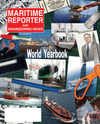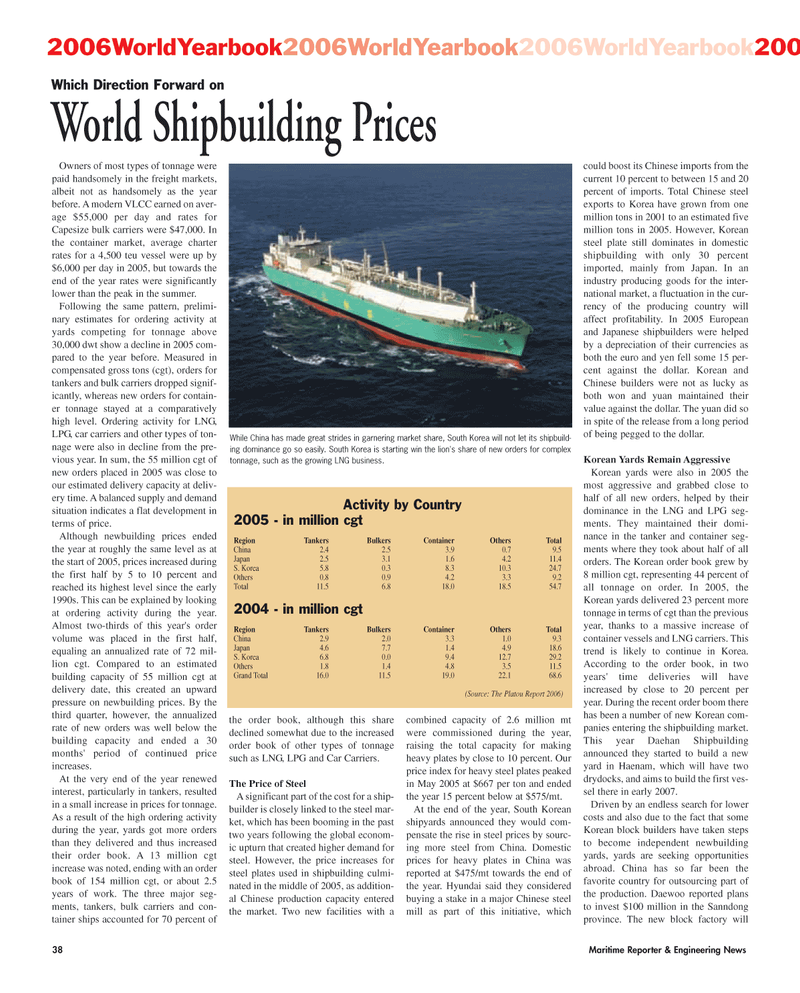
Page 38: of Maritime Reporter Magazine (June 2006)
Annual World Yearbook
Read this page in Pdf, Flash or Html5 edition of June 2006 Maritime Reporter Magazine
38 Maritime Reporter & Engineering News
Owners of most types of tonnage were paid handsomely in the freight markets, albeit not as handsomely as the year before. A modern VLCC earned on aver- age $55,000 per day and rates for
Capesize bulk carriers were $47,000. In the container market, average charter rates for a 4,500 teu vessel were up by $6,000 per day in 2005, but towards the end of the year rates were significantly lower than the peak in the summer.
Following the same pattern, prelimi- nary estimates for ordering activity at yards competing for tonnage above 30,000 dwt show a decline in 2005 com- pared to the year before. Measured in compensated gross tons (cgt), orders for tankers and bulk carriers dropped signif- icantly, whereas new orders for contain- er tonnage stayed at a comparatively high level. Ordering activity for LNG,
LPG, car carriers and other types of ton- nage were also in decline from the pre- vious year. In sum, the 55 million cgt of new orders placed in 2005 was close to our estimated delivery capacity at deliv- ery time. A balanced supply and demand situation indicates a flat development in terms of price.
Although newbuilding prices ended the year at roughly the same level as at the start of 2005, prices increased during the first half by 5 to 10 percent and reached its highest level since the early 1990s. This can be explained by looking at ordering activity during the year.
Almost two-thirds of this year's order volume was placed in the first half, equaling an annualized rate of 72 mil- lion cgt. Compared to an estimated building capacity of 55 million cgt at delivery date, this created an upward pressure on newbuilding prices. By the third quarter, however, the annualized rate of new orders was well below the building capacity and ended a 30 months' period of continued price increases.
At the very end of the year renewed interest, particularly in tankers, resulted in a small increase in prices for tonnage.
As a result of the high ordering activity during the year, yards got more orders than they delivered and thus increased their order book. A 13 million cgt increase was noted, ending with an order book of 154 million cgt, or about 2.5 years of work. The three major seg- ments, tankers, bulk carriers and con- tainer ships accounted for 70 percent of the order book, although this share declined somewhat due to the increased order book of other types of tonnage such as LNG, LPG and Car Carriers.
The Price of Steel
A significant part of the cost for a ship- builder is closely linked to the steel mar- ket, which has been booming in the past two years following the global econom- ic upturn that created higher demand for steel. However, the price increases for steel plates used in shipbuilding culmi- nated in the middle of 2005, as addition- al Chinese production capacity entered the market. Two new facilities with a combined capacity of 2.6 million mt were commissioned during the year, raising the total capacity for making heavy plates by close to 10 percent. Our price index for heavy steel plates peaked in May 2005 at $667 per ton and ended the year 15 percent below at $575/mt.
At the end of the year, South Korean shipyards announced they would com- pensate the rise in steel prices by sourc- ing more steel from China. Domestic prices for heavy plates in China was reported at $475/mt towards the end of the year. Hyundai said they considered buying a stake in a major Chinese steel mill as part of this initiative, which could boost its Chinese imports from the current 10 percent to between 15 and 20 percent of imports. Total Chinese steel exports to Korea have grown from one million tons in 2001 to an estimated five million tons in 2005. However, Korean steel plate still dominates in domestic shipbuilding with only 30 percent imported, mainly from Japan. In an industry producing goods for the inter- national market, a fluctuation in the cur- rency of the producing country will affect profitability. In 2005 European and Japanese shipbuilders were helped by a depreciation of their currencies as both the euro and yen fell some 15 per- cent against the dollar. Korean and
Chinese builders were not as lucky as both won and yuan maintained their value against the dollar. The yuan did so in spite of the release from a long period of being pegged to the dollar.
Korean Yards Remain Aggressive
Korean yards were also in 2005 the most aggressive and grabbed close to half of all new orders, helped by their dominance in the LNG and LPG seg- ments. They maintained their domi- nance in the tanker and container seg- ments where they took about half of all orders. The Korean order book grew by 8 million cgt, representing 44 percent of all tonnage on order. In 2005, the
Korean yards delivered 23 percent more tonnage in terms of cgt than the previous year, thanks to a massive increase of container vessels and LNG carriers. This trend is likely to continue in Korea.
According to the order book, in two years' time deliveries will have increased by close to 20 percent per year. During the recent order boom there has been a number of new Korean com- panies entering the shipbuilding market.
This year Daehan Shipbuilding announced they started to build a new yard in Haenam, which will have two drydocks, and aims to build the first ves- sel there in early 2007.
Driven by an endless search for lower costs and also due to the fact that some
Korean block builders have taken steps to become independent newbuilding yards, yards are seeking opportunities abroad. China has so far been the favorite country for outsourcing part of the production. Daewoo reported plans to invest $100 million in the Sanndong province. The new block factory will 2006WorldYearbook2006WorldYearbook2006WorldYearbook2006W
Which Direction Forward on
World Shipbuilding Prices
While China has made great strides in garnering market share, South Korea will not let its shipbuild- ing dominance go so easily. South Korea is starting win the lion's share of new orders for complex tonnage, such as the growing LNG business.
Activity by Country 2005 - in million cgt
Region Tankers Bulkers Container Others Total
China 2.4 2.5 3.9 0.7 9.5
Japan 2.5 3.1 1.6 4.2 11.4
S. Korea 5.8 0.3 8.3 10.3 24.7
Others 0.8 0.9 4.2 3.3 9.2
Total 11.5 6.8 18.0 18.5 54.7 2004 - in million cgt
Region Tankers Bulkers Container Others Total
China 2.9 2.0 3.3 1.0 9.3
Japan 4.6 7.7 1.4 4.9 18.6
S. Korea 6.8 0.0 9.4 12.7 29.2
Others 1.8 1.4 4.8 3.5 11.5
Grand Total 16.0 11.5 19.0 22.1 68.6 (Source: The Platou Report 2006)
MR JUNE2006 #5 (33-40).qxd 6/2/2006 11:15 AM Page 38

 37
37

 39
39
